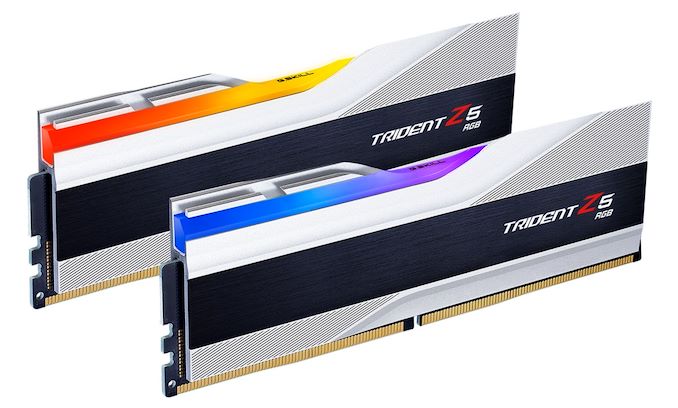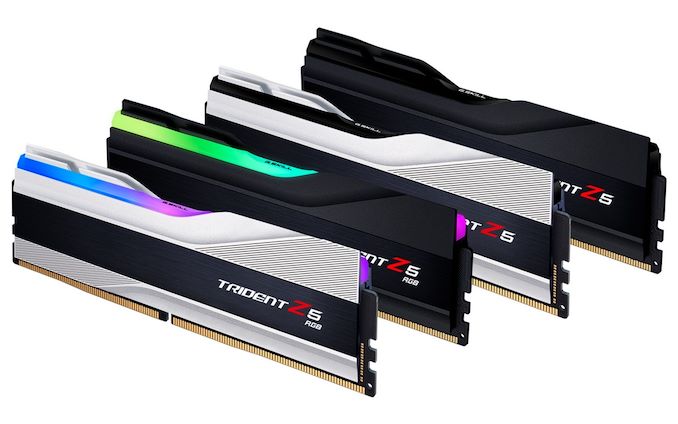G.Skill Unveils Premium Trident Z5 and Z5 RGB DDR5 Memory, Up To DDR5-6400 CL36
by Gavin Bonshor on October 15, 2021 10:00 AM EST
With memory manufacturers clamoring over themselves to push out DDR5 in time for the upcoming launch of Intel's Alder Lake processors, G.Skill has unveiled its latest premium Trident Z5 kits. The latest Trident kits are based on Samsung's new DDR5 memory chips and range in speed from DDR5-5600 to DDR5-6400, with latencies of either CL36 or CL40. Meanwhile, G.Skill has also opted to use this opportunity to undertake a complete design overhaul from its previous DDR4 memory, with a fresh new look and plenty of integrated RGB.
| G.Skill Trident Z5 DDR5 Memory Specifications | |||
| Speed | Latencies | Voltage | Capacity |
| DDR5-6400 | 36-36-36-76 40-40-40-76 |
??? | 32 GB (2 x 16 GB) |
| DDR5-6000 | 36-36-36-76 40-40-40-76 |
??? | 32 GB (2 x 16 GB) |
| DDR5-5600 | 36-36-36-76 40-40-40-76 |
??? | 32 GB (2 x 16 GB) |
Looking at performance, the top SKU comes with fast speeds of DDR5-6400, with either a latency of CL 36-36-36-76 or CL 40-40-40-76. Both the lower-rated kits of DDR5-6000 and DDR5-5600 are available with the same latencies, while all of the six combinations will be available in 32 GB kits, with 2 x 16 GB memory modules. The new G.Skill Trident Z5 and Z5 RGB memory kits will also feature the latest Samsung memory ICs, with G.Skill hand screening the memory chips themselves to ensure maximum stability and performance.
At the time of writing, G.Skill hasn't confirmed the operating voltages of each kit. G.Skill also hasn't unveiled its pricing at this time, but it did say that the Trident Z5 and Trident Z5 RGB kits will be available from November.
Meanwhile in terms of aesthetics, the G.Skill Trident Z5 DDR5 memory features a new design compared with previous Trident Z series kits. The Trident Z5 comes with a new dual texture heat spreader design and is available either with a black top bar (Z5) or a new translucent RGB light bar (Z5 RGB). It's also available in black and silver, with a black brushed aluminum insert across both colors, making it stand out.
With the RGB enabled G.Skill Trident Z5 RGB DDR5 memory kits, the lighting can be customized via its Trident Z lighting control software or synced with other third-party software supplied by vendors such as ASRock, ASUS, GIGABYTE, and MSI's own RGB software.

















24 Comments
View All Comments
ballsystemlord - Friday, October 15, 2021 - link
Spelling and grammar errors:"... with a fresh new look and plenty of integrated RGB, and is ."
You're missing something here.
Ryan Smith - Friday, October 15, 2021 - link
Thanks!ballsystemlord - Friday, October 15, 2021 - link
I thought the move to DDR5 was supposed to herald larger RAM capacities, not the same 16GB per stick size.Wereweeb - Friday, October 15, 2021 - link
EUV manufacturing technology will allow for larger capacities, but 99% of people still need just 16GB of RAM.DougMcC - Friday, October 15, 2021 - link
Even if you're just browsing the web top 100 sites, 32G is a big help these days. JS cpu/memory usage has shot through the roof.Alistair - Friday, October 15, 2021 - link
noUnashamed_unoriginal_username_x86 - Saturday, October 16, 2021 - link
noPapaspud - Saturday, October 16, 2021 - link
No it isn't, I actually opened up as many tabs as I felt like- must have been about 50, my memory usage got up to 13. something gigs. Not sure why you would need 100's of tabs at the same time.ballsystemlord - Saturday, October 16, 2021 - link
Very true. I'm at 24GB mostly due to websites with unreasonable JS code.FullmetalTitan - Friday, October 15, 2021 - link
Go look at late DDR3 modules next to first launched DDR4 modules, or DDR2/DDR3. This has always been the case that you get similar modules with newer voltage and timing specs, and a small speed bump first, then as the process matures DIMMs start to double in size and push speed out further